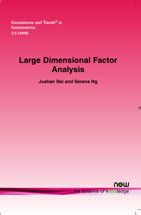Large Dimensional Factor Analysis
By Jushan Bai, Department of Economics, New York University, USA, Jushan.Bai@nyu.edu | Serena Ng, Economics Department, Columbia University, USA, Serena.Ng@columbia.edu
Abstract
Econometric analysis of large dimensional factor models has been a heavily researched topic in recent years. This review surveys the main theoretical results that relate to static factor models or dynamic factor models that can be cast in a static framework. Among the topics covered are how to determine the number of factors, how to conduct inference when estimated factors are used in regressions, how to assess the adequacy of observed variables as proxies for latent factors, how to exploit the estimated factors to test unit root tests and common trends, and how to estimate panel cointegration models. The fundamental result that justifies these analyses is that the method of asymptotic principal components consistently estimates the true factor space. We use simulations to better understand the conditions that can affect the precision of the factor estimates.
Large Dimensional Factor Analysis
Large Dimensional Factor Analysis provides a survey of the main theoretical results for large dimensional factor models, emphasizing results that have implications for empirical work. The authors focus on the development of the static factor models and on the use of estimated factors in subsequent estimation and inference.
Large Dimensional Factor Analysis discusses how to determine the number of factors, how to conduct inference when estimated factors are used in regressions, how to assess the adequacy pf observed variables as proxies for latent factors, how to exploit the estimated factors to test unit root tests and common trends, and how to estimate panel cointegration models.
